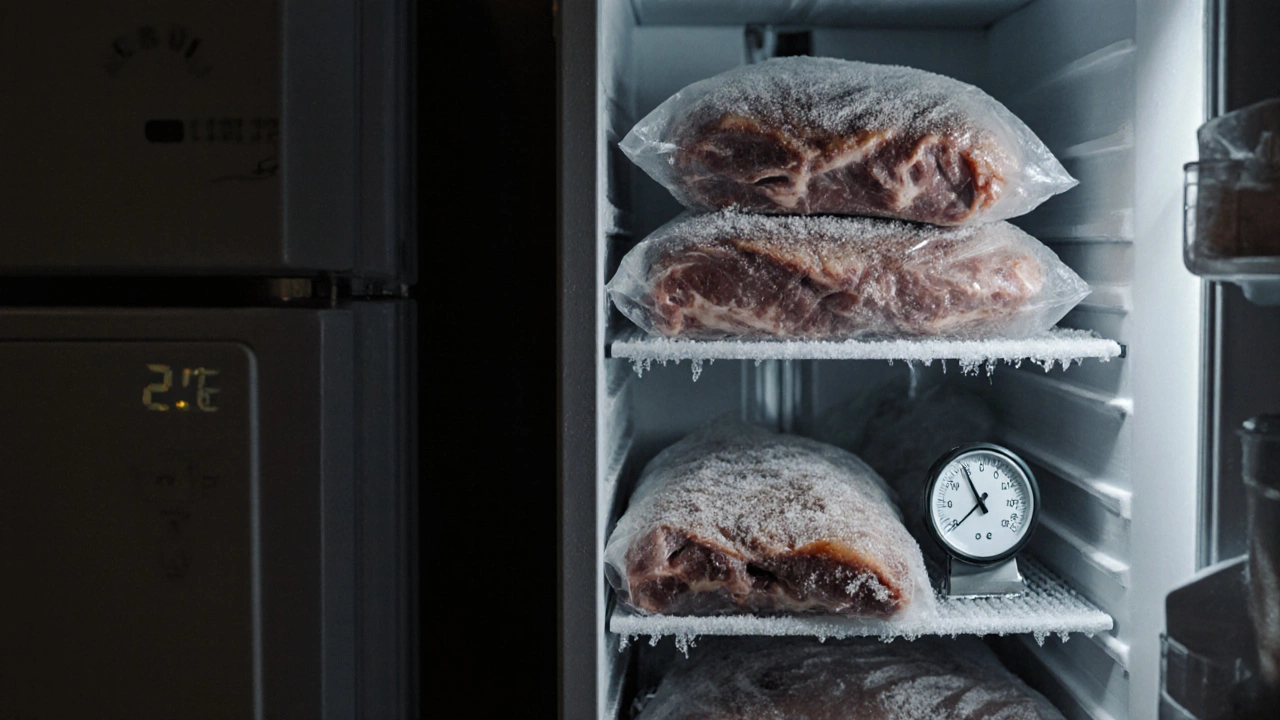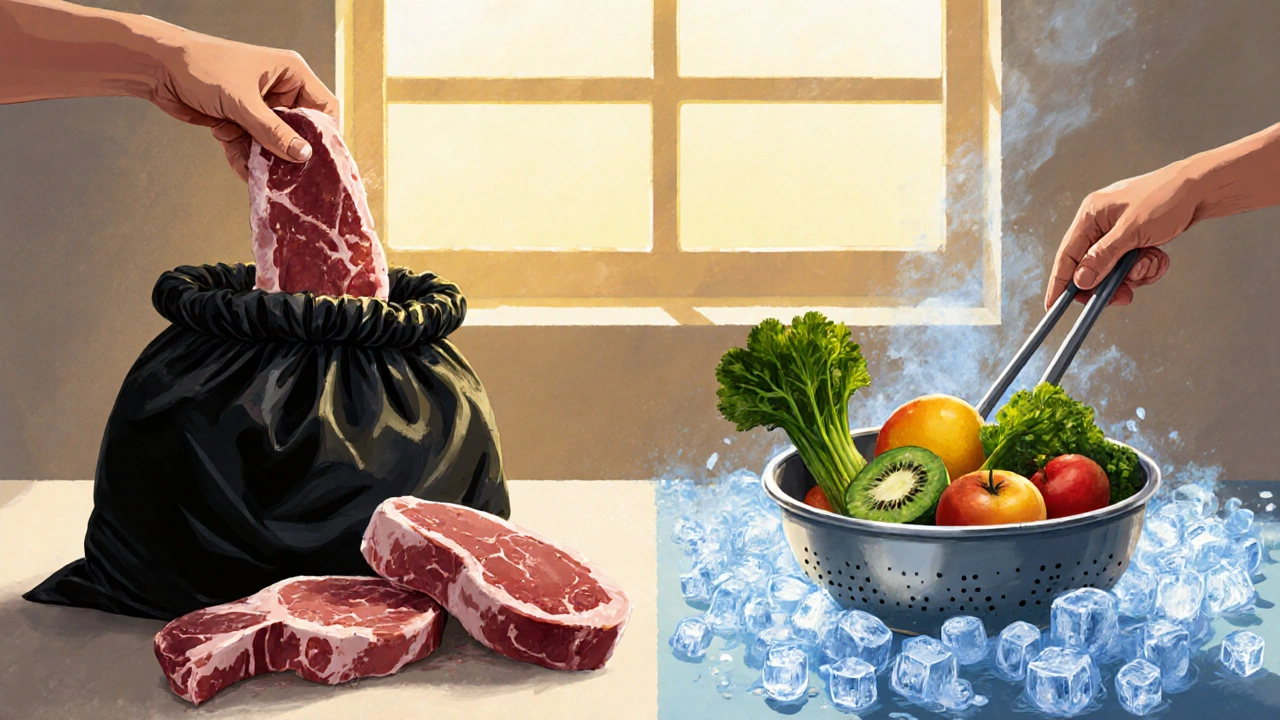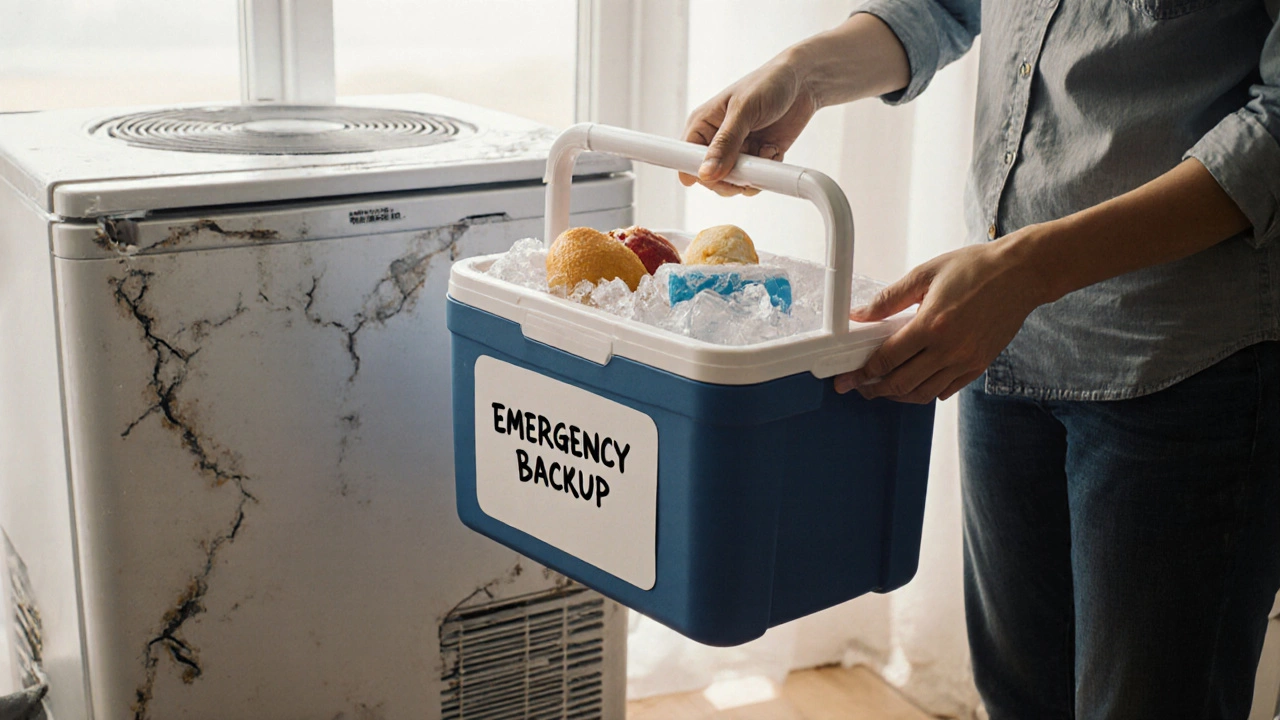
- 8 Nov 2025
- Gideon Thornton
- 0
Freezer Safety Calculator
How long can your frozen food stay safe?
Enter the details below to determine if your food is safe to refreeze or should be discarded.
Food Safety Results
If your freezer suddenly stops working, your first thought is probably: is my food still safe? It’s not just about wasting money - it’s about avoiding food poisoning. The good news? Most frozen food stays safe longer than you think. The bad news? You have to act fast, and you need to know exactly when to toss things.
How long can food stay safe without power?
A full freezer will keep food frozen for about 48 hours if the door stays shut. A half-full freezer? About 24 hours. This isn’t a guess - it’s based on USDA guidelines and real-world tests done by food safety labs. The key is insulation and how full the freezer is. More food = more cold mass = slower thawing.Think of your freezer like a thermos. The more packed it is, the better it holds onto the cold. If you’ve got a few bags of peas and a half-empty ice cube tray, things will warm up fast. But if your freezer is crammed with meat, veggies, and frozen meals? You’ve got breathing room.
Check the temperature - don’t guess
Don’t rely on how cold the food feels. That’s risky. Use a thermometer. If you’ve got a freezer thermometer (most modern ones do), check the internal temperature. If it’s still at or below 4°C (40°F), your food is generally safe to refreeze or cook.Here’s the hard truth: once food hits 4°C for more than two hours, bacteria like Listeria and Salmonella can start multiplying. That’s why you can’t just look at ice crystals and assume everything’s fine. A steak might still feel icy on the outside but be warm inside. Always measure.
What to keep, what to toss
Not all frozen food reacts the same way. Here’s a simple guide:- Keep if still frozen solid or at or below 4°C: Raw meats, poultry, seafood, frozen meals, ice cream, frozen vegetables, and fruits.
- Throw away if thawed and above 4°C: Raw or cooked meats, poultry, seafood that are soft, sticky, or have an odd smell.
- Always toss: Thawed and refrozen ice cream, frozen yogurt, or anything with a creamy texture - they separate and become unsafe to eat, even if cold.
- Use quickly: Frozen vegetables and fruits that are partially thawed but still cold can be cooked or blended into smoothies. Don’t refreeze them.
When in doubt, smell it. Spoiled meat smells sour, cheesy, or like ammonia. Fish smells overly fishy, not briny. If it looks slimy, discoloured, or has odd spots - toss it. No exceptions.
What if the power comes back on?
If the power returns and your freezer is cold again, don’t rush to refill it. Wait at least 24 hours before adding new food. The unit needs time to stabilize. Putting warm groceries in too soon can cause the temperature to spike again, risking everything inside.Also, clean the freezer before restocking. If any food leaked during the outage, wipe down shelves and drawers with hot, soapy water. Bacteria can linger on surfaces, even after the power’s back on.

How to prepare before the next outage
Freezer failures aren’t always random. In Bristol, winter power cuts are more common. Here’s how to avoid panic next time:- Keep a freezer thermometer inside - set an alert if it rises above 4°C.
- Don’t overfill your freezer, but don’t leave it empty either. Half-full is ideal for balance.
- Label everything with the date you froze it. Use masking tape and a marker.
- Keep a cooler and ice packs ready. If you know a storm’s coming, move high-value items (like a whole turkey or bulk meat) into a cooler with dry ice or frozen gel packs.
- Know your freezer’s model and warranty. Some manufacturers offer compensation if the unit fails due to a manufacturing defect.
When to call a repair technician
If your freezer stopped working and you’re not sure why, don’t just unplug and plug it back in. That can damage the compressor. Instead, check these common causes:- Is the plug loose or the outlet dead? Test with another device.
- Is the condenser coil dusty? Vacuum it. Dust buildup is the #1 reason freezers overheat.
- Is the door seal cracked or leaking? Run a dollar bill along the edge. If it pulls out easily, the seal needs replacing.
- Is the freezer making strange noises? Clicking, buzzing, or humming could mean the compressor is failing.
If none of these fixes work, call a certified appliance technician. A compressor replacement can cost £300-£500, but if your freezer is under 8 years old, it’s usually worth it. Older units? Consider upgrading to an energy-efficient model. New freezers use up to 40% less power and keep food colder during outages.
What happens to food that’s been warm too long?
Eating spoiled frozen food won’t always make you sick right away. But the risk is real. Listeria can grow even in cold temps, and it’s especially dangerous for pregnant women, the elderly, and people with weak immune systems. Salmonella and E. coli can survive freezing and come back to life once food warms up.There’s no magic way to “kill” bacteria by cooking spoiled meat. If it’s been above 4°C for more than two hours, cooking won’t make it safe. The toxins produced by bacteria don’t break down with heat. That’s why tossing it is the only safe choice.

What about ice cream and frozen desserts?
Ice cream, sorbet, and frozen yogurt are the first to go. Even if they look frozen, their texture changes permanently when they thaw and refreeze. You get gritty, icy chunks instead of smooth creaminess. More importantly, dairy-based desserts are breeding grounds for bacteria when they warm up. If it’s soft, melted, or smells off - throw it out. No second chances.How to document damage for insurance
If your freezer failed due to a power surge or appliance defect, your home insurance might cover the lost food. Most policies cover up to £500-£1,000 in food loss, but you need proof.- Take photos of the thawed food before tossing it.
- Keep receipts for anything you bought recently - even if it’s not fully spoiled.
- Write down what you lost: “20 lbs of ground beef, 3 frozen turkeys, 15 frozen meals.”
- Get a written report from the repair technician if the freezer is broken.
Insurance companies don’t pay for food lost due to a power outage unless it’s tied to a covered event like lightning or a storm. But if the freezer itself broke, you’re likely covered.
Final rule: When in doubt, throw it out
It’s tempting to save money by keeping questionable food. But food poisoning can cost you more than the price of a whole freezer’s worth of groceries. Hospital bills, missed work, and weeks of illness aren’t worth risking.Every year in the UK, over 2.4 million cases of foodborne illness are reported. A large portion comes from improper food storage after appliance failure. Don’t become a statistic. When your freezer stops, act quickly, check temperatures, and be ruthless with what you toss.
Your food isn’t just a cost - it’s your health. And when it comes to safety, there’s no such thing as being too careful.
How long can frozen food stay safe if the freezer stops working?
A full freezer can keep food safe for up to 48 hours without power if the door stays closed. A half-full freezer lasts about 24 hours. The key is keeping the door shut and knowing the internal temperature - if it stays at or below 4°C, most food is still safe to refreeze or cook.
Can I refreeze food that has partially thawed?
Yes, if the food still contains ice crystals and has stayed at or below 4°C. Raw meats, poultry, and frozen meals can be safely refrozen. But if the food has warmed above 4°C for more than two hours, or if it smells odd or feels slimy, throw it away. Never refreeze dairy-based items like ice cream or yogurt - they become unsafe and lose texture.
What should I do if my freezer stops working during a power cut?
Keep the freezer door closed. Don’t open it unless absolutely necessary. Use a thermometer to check the internal temperature. If the power outage lasts longer than 24 hours and you’re unsure, move perishable items to a cooler with ice packs. Contact a repair technician if the freezer doesn’t restart after power returns.
How do I know if frozen meat has gone bad?
Check for three signs: smell, texture, and colour. Spoiled meat smells sour, ammonia-like, or off. It may feel sticky or slimy to the touch. Discolouration - like green, grey, or dark brown patches - means it’s spoiled. If any of these are present, toss it. Even if it looks frozen, bacteria can grow during partial thawing.
Can I use a cooler to save food during a freezer failure?
Yes. A cooler with ice packs or dry ice is a great temporary solution. Pack food tightly, use frozen gel packs or blocks of ice, and keep the lid closed. This can extend safety by 24-48 hours, depending on how cold the ice stays. It’s especially useful for high-value items like whole turkeys or bulk meat.
Should I call a repair technician if my freezer won’t turn back on?
Yes, if the freezer doesn’t restart after checking the plug, outlet, and condenser coils. A failed compressor, faulty thermostat, or broken start relay often requires professional repair. Don’t keep trying to turn it on - that can cause more damage. A technician can diagnose the issue and tell you whether repair or replacement is more cost-effective.
Next steps: If your freezer is over 10 years old, consider replacing it. Newer models have better insulation, temperature alarms, and energy efficiency. If you’ve lost food due to a failure, document everything for insurance. And next time - keep a thermometer inside, label your items, and have a cooler ready.

